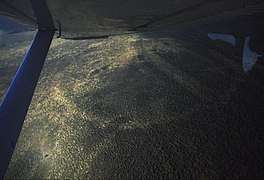Forest ring
Forest rings are large, circular patterns of low tree density in the boreal forests of northern Canada.[2][3][4] These rings can range from 50 metres (160 ft) to nearly 2 kilometres (1.2 mi) in diameter, with rims about 20 metres (66 ft) in thickness.[2] The origin of forest rings is not known, despite several mechanisms for their creation having been proposed. Such hypotheses include radially growing fungus, buried kimberlite pipes, trapped gas pockets, and meteorite impact craters.[4]

History
Because of their large scale, forest rings are not apparent from the ground, and it was not until aerial photography became a common surveying tool in the 1950s that geologists began to notice them.[5][6] The term "forest ring" was coined by The Ontario Geological Survey to differentiate the phenomenon from fairy rings.[3]
Hypothesis
Biological
Forest rings were originally thought to be caused by the radial growth of fungi within the root system of black spruce (Picea mariana), possibly the fungus Armillaria ostoyae. A ring would begin as a single point of infection and grow outward in all directions. Affected trees would die in the interior of the circle, and eventually new trees would grow in their place. The fungal mat would become ring-shaped and visible from above as a circular ring of stunted trees.[6] The fungal hypothesis is no longer favoured as there is little compelling evidence to support it. Observations of forest rings in the Abitibi region of Quebec have found no evidence of mass tree mortality by a pathogen.[4]
It was further hypothesized that bacteria, such as Geobacter, might be contributing to the ring formation.[7][8] Their capability to form conducting nanowires or pili and to perform directional electron transport might contribute to a circular charge transfer from the electron-rich center of the ring towards the ring edges.[9] The so-catalyzed oxidation processes increase acidity and dissolve carbonates, thus creating a depression, and, accordingly, the ring edge. Recent microbiological investigations indeed show a high abundance of Geobacter at the ring edge.[10]
Outside of Canada
Forest rings have also been reported in Russia and Australia.[5]
References
- Murphy, Ray (2007-04-26). "Boreal Forest Rings". EPOD. Retrieved 2016-12-09.
- Hamilton, S.M.; Cranston, D.R. (2000). "Thick Overburden Geochemistry – Methods and Case Studies". Ontario Geological Survey Open File Report, Summary of Field Work and Other Activities 2000. Ontario Ministry of Northern Development and Mines, Ontario Geological Survey. 6032: 10–17.
- Brauneder, Kerstin; Hamilton, Stewart M.; Hattori, Keiko (2016). "Geochemical processes in the formation of 'forest rings': examples of reduced chimney formation in the absence of mineral deposits". Geochemistry: Exploration, Environment, Analysis. 16 (1): 85–99. doi:10.1144/geochem2015-360. ISSN 1467-7873.
- Giroux, Jean-François; Bergeron, Yves; Veillette, Jean J (2001). "Dynamics and morphology of giant circular patterns of low tree density in black spruce stands in northern Quebec". Canadian Journal of Botany. 79 (4): 420–428. doi:10.1139/b01-022. ISSN 0008-4026.
- Andra-Warner, Elle (2008-05-21). "The mysterious forest rings of northern Ontario". CBC News. Canadian Broadcasting Corporation. Retrieved 2016-12-08.
- Veillette, J.J.; Giroux, J-F. (1999). "The enigmatic rings of the James Bay Lowland: a probable geological origin". Geological Survey of Canada, Open File (3708). doi:10.4095/210206. Retrieved 2017-02-24.
- Hamilton, Stewart M.; Hattori, Keiko H. (May 2008). "Spontaneous potential and redox responses over a forest ring". Geophysics. 73 (3): B67–B75. doi:10.1190/1.2890287.
- Hamilton, S.M.; Govett, G.J.S. (2010). "Vertical Dispersion of Elements in Thick Transported Cover Above the Thalanga Zn-Pb-Cu Deposit, Queensland, Australia: Evidence of Redox-Induced Electromigration". Special Publication. Society of Economic Geologists. 2 (15): 391–398.
- Reguera, Gemma; McCarthy, Kevin D.; Mehta, Teena; Nicoll, Julie S.; Tuominen, Mark T.; Lovley, Derek R. (23 June 2005). "Extracellular electron transfer via microbial nanowires". Nature. 435 (7045): 1098–1101. doi:10.1038/nature03661. PMID 15973408.
- von Gunten, Konstantin; Hamilton, Stewart; Zhong, Cheng; Nesbø, Camilla; Li, Jiaying; Muehlenbachs, Karlis; Konhauser, Kurt; Alessi, Daniel (2018). "Electron donor‐driven bacterial and archaeal community patterns along forest ring edges in Ontario, Canada". Environmental Microbiology Reports. doi:10.1111/1758-2229.12678. PMID 30014579.